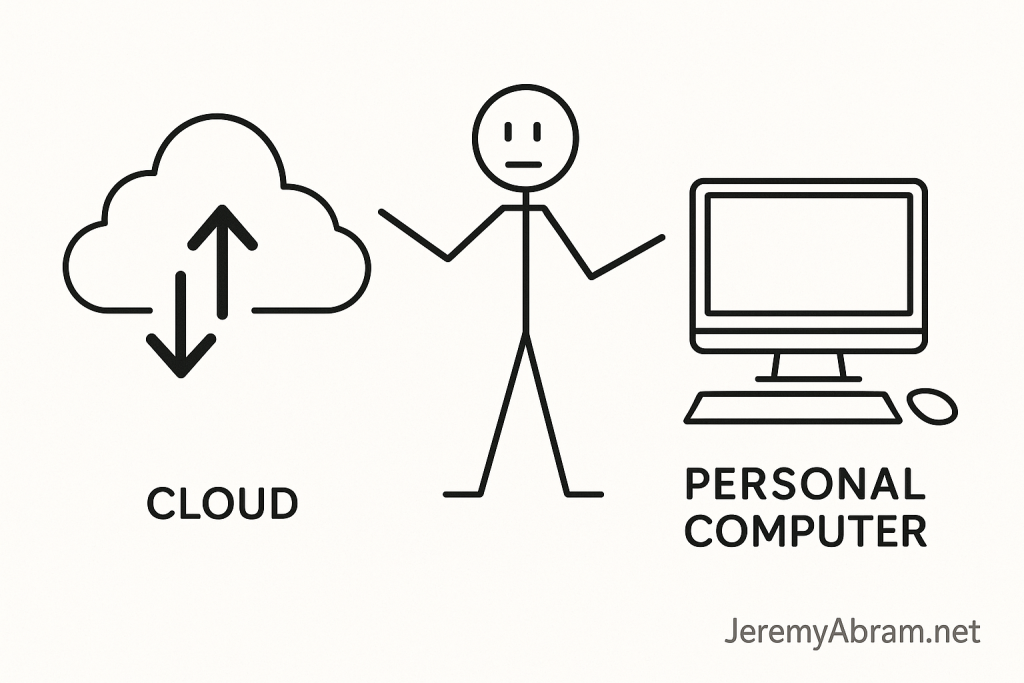
Local autonomy vs. cloud-managed ownership
For decades, personal computing was defined by a simple principle: your machine, your data, your control. You installed software, stored files locally, and decided what stayed, what changed, and what ran. Today, a quieter—but profound—shift is underway. Increasingly, the tools we rely on live not in our devices, but in remote data centers controlled by corporations.
This transition—from self-contained computing to cloud-reliant ecosystems—promises convenience, collaboration, and power previously unimaginable. But beneath the frictionless surface, a new tension is emerging: the loss of sovereignty over our own devices, data, and digital lives.
This is not a war of weapons or armies—it is a war of defaults, designs, and dependencies. And most people don’t even know they’re fighting it.
The Era of Local Sovereignty
From the 1980s to the early 2000s, personal computing meant empowerment.
- Install any software you choose
- Store files entirely offline
- Customize and modify your system freely
- Run programs without needing approval from a vendor
Your computer was a tool, not a terminal.
Even when the internet entered the picture, it supplemented local power—it didn’t replace it. We backed up files to external drives. We purchased software once and used it indefinitely. If a company went out of business, our programs still ran.
Local computing was imperfect, but it was free, resilient, and sovereign.
The Cloud Revolution
Cloud computing flipped the model overnight. Instead of owning software outright, we rent access to hosted platforms:
| Local Era | Cloud Era |
|---|---|
| You owned software | You rent access |
| Devices operate offline | Constant internet dependency |
| End-user control | Vendor control |
| Permanent ownership | Subscription expiration |
| Open system tinkering | Closed, permission-gated systems |
Cloud services deliver enormous value—global access, infinite storage, real-time collaboration, machine learning, and automated updates. The convenience is undeniable.
But convenience can hide a trade-off: control moves upward, away from the user.
Cloud systems increasingly enforce:
- Remote disabling and remote updates
- Data stored beyond user reach
- File scanning and analysis
- Subscription locks and access revocation
- Feature changes without consent
- AI-driven oversight and policy enforcement
In short, the cloud didn’t just bring capability—it brought governance.
Digital Ownership Is Becoming Digital Permission
Today, buying technology rarely means owning it.
You “purchase” e-books that can be revoked.
You subscribe to software that stops working if payments lapse.
You stream music rather than download it.
You use AI models only through controlled interfaces.
Screens we hold are no longer sovereign devices—they are portals into someone else’s environment.
Even vehicles and appliances increasingly require cloud authentication to operate. Cars refuse to start without server validation. Tractors demand online authorization to repair. Smart homes rely on corporate servers to unlock doors or run thermostats.
The question emerges:
If a tool can be remotely disabled, can you truly own it?
The Silent Erosion of User Agency
What was once a technical shift is now a philosophical one.
Cloud ecosystems reshape user behavior:
- We trust unseen infrastructure blindly
- We tolerate terms of service that can change at any time
- We rely on central authorities to manage security, storage, identity
- We accept the idea that full control is not meant for everyday users
Autonomy gives way to automation.
Ownership gives way to oversight.
Computers become managed experiences, not personal machines.
And like any slow drift, most don’t notice until the destination is reached.
Why Local Computing Still Matters
Local computing is not nostalgic—it is strategic.
Local capability means:
- Data stays under personal control
- Software operates regardless of corporate decisions
- Machines function offline and without permission
- Systems remain modifiable and transparent
- Privacy and sovereignty remain possible
It is not cloud versus local—it is balance.
The danger lies in tipping fully toward dependency without realizing what we lost.
The Next Frontier: Personal AI vs Cloud AI
AI accelerates this divide.
Cloud-based AI:
- Centralized models
- Centralized control
- User data for training
- Policy-gated access
- Potential for de-platforming and revocation
Personal AI:
- Runs locally
- Private and unmonitored
- Customizable and transparent
- No dependency on external servers
As local models grow powerful and efficient, they may become the new frontier of digital self-determination.
Just as early PCs freed individuals from mainframes, local AI may free us from the centralized intelligence networks of the cloud age.
Choosing Your Digital Future
You don’t have to abandon the cloud; it has reshaped the world for the better.
But sovereignty requires intentional architecture:
✅ Keep local copies of files
✅ Use software that runs offline when possible
✅ Maintain local passwords, backups, and hardware
✅ Support open-source and community-built tools
✅ Pair cloud capability with local resilience
The cloud should serve us—not own us.
Conclusion: Freedom in the Age of Silent Dependencies
The shift to cloud computing is not inherently malicious. But if users become passive tenants of corporate computing environments, we risk losing the creative and civic power that personal machines originally granted us.
The quiet war for local control is not about rejecting progress—it is about ensuring that progress does not erase individual agency in the digital world.
The machines in our homes once symbolized independence. They still can.
But only if we remember that convenience without control is not freedom—it is dependence disguised as luxury.
Leave a Reply